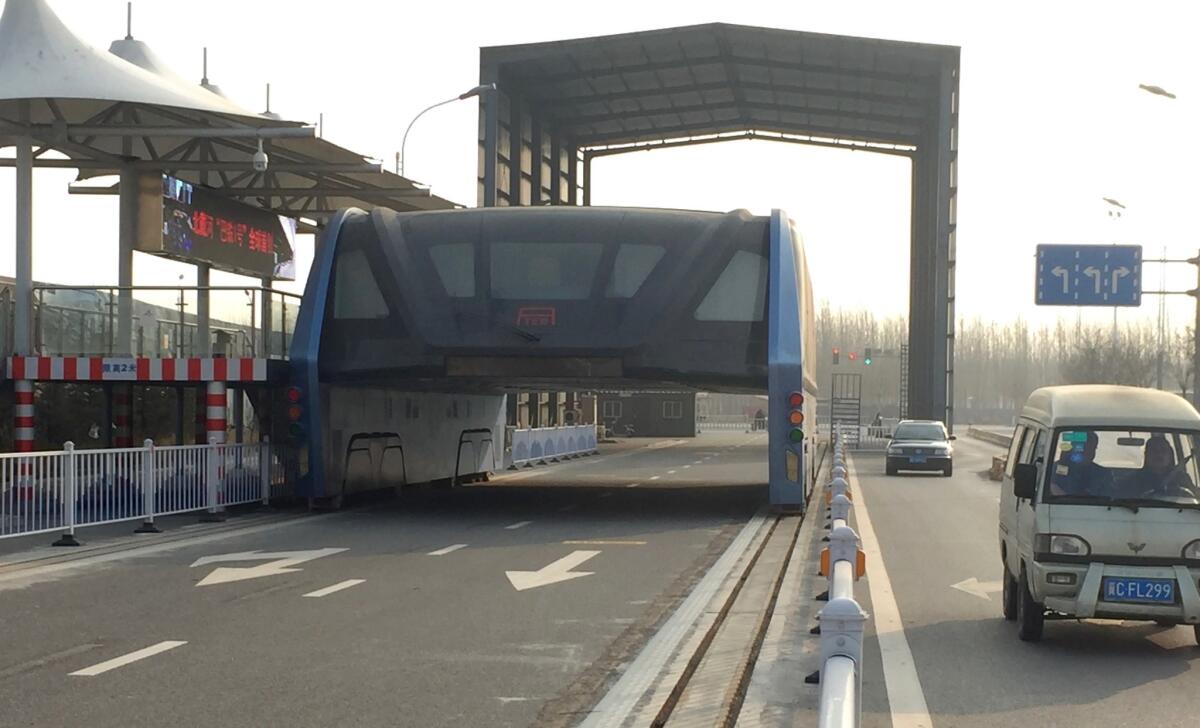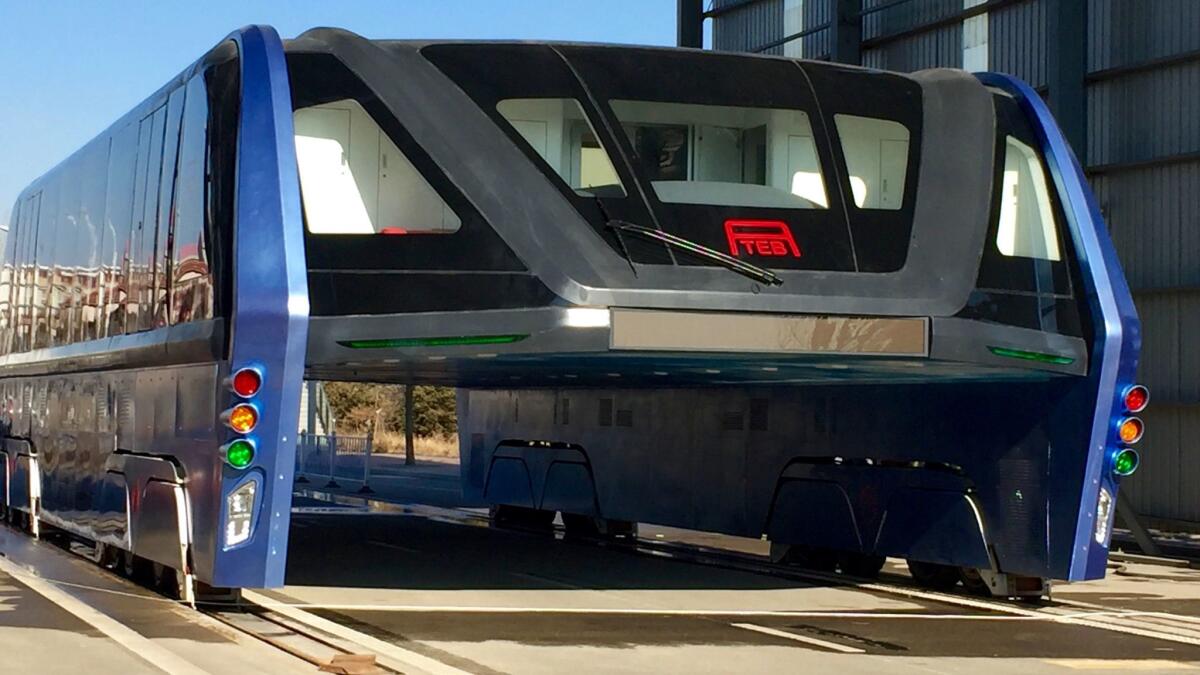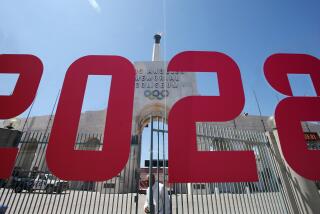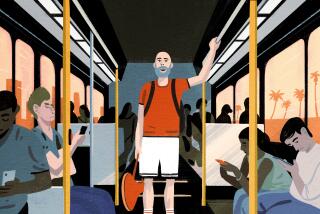A bus that straddled traffic was supposed to solve this Chinese city’s traffic woes. What could go wrong?

The contraption straddles half of a four-lane road. Arctic blue and nearly a quarter the length of a football field, the bus-train hybrid looks like a prop built for a “Transformers” sequel. (Jan. 13, 2017)
Reporting from Qinhuangdao, China — The contraption straddles half of a four-lane road. Arctic blue and nearly a quarter the length of a football field, the bus-train hybrid looks like a prop built for a “Transformers” sequel.
A passenger compartment hovers above the asphalt, designed so cars can zip beneath as riders glide above the gridlock.
The Transit Elevated Bus landed in this northern coastal city last summer, delivering new fame to a place hitherto known primarily for its annual holiday gathering of Communist Party leaders.
By early December, a brown film had settled on the bus’ windshield — until the carwash guys showed up with a platform ladder to scrub the 16-wheeler back to its former glory.
Residents don’t know why the motionless vehicle still occupies one side of the street. The security guards hired to watch the bus rarely leave their heated hut. City officials can’t reach the company, TEB Technology. The doors to its Beijing headquarters are locked, although three disgruntled employees linger in hopes of getting paid.
NEWSLETTER: Get the day’s top headlines from Times Editor Davan Maharaj »

A project intended as a revolutionary solution to China’s traffic-choked cities now faces missing executives and allegations of financial wrongdoing. The town hates it. But was it a swindle or simply the recklessness of the Chinese business landscape, where projects start in a snap and then just as quickly evaporate?
“Useless,” said Kong Lingchuan, 36, as he stocked shelves at his crammed grocery store across the street. “It would be better if someone just removed it.”
::
The idea of a road-straddling bus dates back nearly half a century to an architect in New York who daydreamed during his daily commute on the Staten Island Ferry. The ride was leisurely, pleasant even, as he wandered the decks.
“I thought, ‘Wouldn’t it be great if this was the way travel was on land?’” said Craig Hodgetts, now a principal at Hodgetts + Fung Design and Architecture in Culver City.
That led to the Landliner, a futuristic concept he and a friend created in 1969. New York Magazine put the design on its February front cover with the headline, “This Machine Swallows Buses While Going 60 mph. And Could Make The City Livable.”
Neither could pursue the project, which transportation agencies ignored. Now building this kind of model is “a piece of cake,” he said. “Sometimes it takes a force from outside to do it.”
::
Enter Song Youzhou and Bai Zhiming. Song played the dreamer, an optimist who thought about the benefits before the challenges. Bai was the money guy, an aspiring entrepreneur who liked bold risks.
Song never mentioned Hodgetts’ design. He came up with his own straddling bus while researching designs for parking spots in the southern metropolis of Shenzhen.
“I saw the traffic jams and wondered if it’s possible to make buses high up in the air as well,” he told the New York Times in 2010. Song planned to power the “3D Express Coach” through solar energy and electricity, fitting hundreds of people into a machine that rose above the ground. He showcased the bus at the Beijing International High-Tech Expo. Time magazine selected it as one of the 50 best inventions of the year.
Song’s screen name on China’s popular social media app WeChat, is “New Continent.” He has only an elementary school education, according to state media, but shows remarkable determination. Five years after the parking lot epiphany, his bus dream sounded as though it might actually work.
He’d met Bai, a bespectacled businessman who’d tried his luck with a fast-food chain called Uncle Sam. Bai also attempted to create a paddy that grew nutrient-enriched rice.
The pair struck a deal. Bai bought Song’s patent in exchange for a share of the profit. They named it the Transit Elevated Bus, or Batie, combining the Chinese words for bus and subway, bashi and ditie.
Bai founded TEB in an airy Beijing office with a replica of the bus circling a track. Photos on the walls showed Song and Bai shaking hands with foreign representatives. A TEB delegation approached New York City Mayor Bill de Blasio, who smiled for a picture holding their brochure.
“It’s not only China’s innovation,” Bai told a local newspaper in May. “It’s also the world’s.”

State media praised the environmentally friendly concept, and officials swooned over a demonstration of national innovation. The company selected Qinhuangdao, a two-hour train ride east of Beijing, to hold a test drive down a 330-yard track. Advertisements for a futuristic bus lined one side of the street and elevated platforms stood ready to greet passengers. Batie, clad in a red ribbon, inched forward quietly with two cars nestled underneath. The crowd erupted into applause.
What could go wrong?
::
A few days after the bus’ August preview, Chinese media turned on the company.
They accused TEB of defrauding investors by soliciting crowd funding through a shady peer-to-peer financing scheme. The state-run Global Times highlighted ties between Bai’s transportation company and his other businesses.
Bai is the chairman of a Beijing property conglomerate, according to public documents, that oversees an online funding platform known as Huaying Kailai. The Global Times alleged TEB raised much of its money through that financing company.
Filings show the government blacklisted Huaying Kailai in 2015 for illegal financial activities. None of the companies responded to requests for comment.
Song assured reporters that the money Bai invested into the bus company came from his own pocket, and they broke no laws.
But the euphoria had faded. Articles questioned how the bus could move around traffic and whether cars would get trapped underneath. Additional funding suddenly looked questionable for a project Song claimed would cost about $4.5 million a car.
Song didn’t respond to multiple requests for comment. An official at the Beidaihe district government office had no idea what would happen to the vehicle parked on its road.
“We used to talk with a person in charge of TEB,” she said. “He’s not here anymore and he won’t answer our phone call.”
::
Bai’s office door at the property company was wide open one recent weekday. A receptionist woke from her nap to say she hadn’t seen him.
Another sleepy worker unlocked the door to the TEB offices, 15 floors below. A dusty newspaper dated back to May. Three employees camped out in the side room, the last of 20 who once occupied it. One complained they hadn’t received pay in four months.
In China, live-streaming apps soothe lonely souls and create fortunes »
“I thought this was a promising project,” she said.
In the same complex, the financing company was anything but quiet.
Men herded visitors from a dark room full of angry investors. One looked near a fight. Another shouted, “I put my money in and you didn’t give it back to me, so I’m here asking for money.”
She didn’t say whether it had to do with the bus.
::
Batie also faces logistical hurdles. Analysts warn about wielding a heavy vehicle through the chaos of Chinese streets. The current height would rip up trucks that tried to pass under it.
“It they want to be a success in China or attract government support, they need to highlight the advantage,” said Sylvia He, an assistant professor in the Chinese University of Hong Kong’s urban studies program. “I don’t see a particular edge over any other mode.”
Song hasn’t given up. He told state media in December that TEB had received another investment from a state-owned company focused on energy, but didn’t provide a name.
The most excitement the bus gets these days comes from bystanders who sidestep a guardrail to take photos.
“It looks like an iron bucket,” Zhang Dong said with a chuckle. The 35-year-old heard about the bus in the news and came to see it for himself.
He started walking away but turned back to stare.
Meyers is a special correspondent. Yingzhi Yang and Nicole Liu in The Times’ Beijing bureau contributed to this report.
Twitter: @jessicameyers
ALSO
This roadside salesman outside Kabul is known for selling the best hashish: ‘Everyone loves me’
More to Read
Sign up for Essential California
The most important California stories and recommendations in your inbox every morning.
You may occasionally receive promotional content from the Los Angeles Times.










